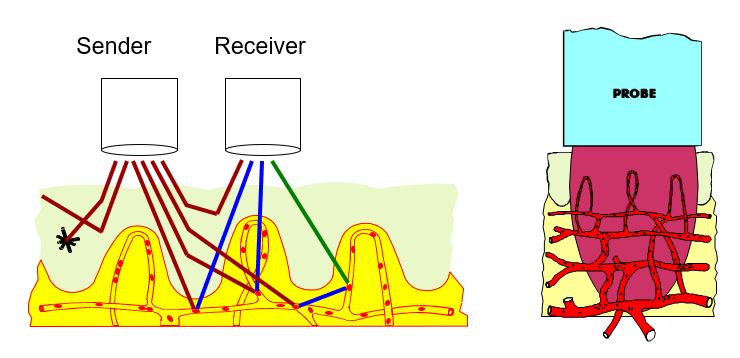Laser Doppler Perfusion Monitoring (LDPM)
![]()
Laser Doppler perfusion monitoring measures the total local microcirculatory blood perfusion including the perfusion in capillaries (nutritive flow), arterioles, venules and shunting vessels. The definition of perfusion is the concentration of red blood cells times their average velocity. Perfusion reflects the total flow activity, i.e. all motion of red blood cells in the tissue volume, rather than a net flow through the sampling volume. The LDPM technique is based on the emission of a beam of laser light carried by a fiber-optic probe.

The light is scattered and partly absorbed by the tissue being studied. Light hitting the moving red blood cells undergoes a change in frequency (Doppler shift) while light hitting static objects is unchanged. The magnitude and frequency distribution of these Doppler shifts are directly related to the number and velocity of red blood cells in the sampling volume. The information is picked up by a returning fiber, converted into an electronic signal and analyzed.
The measurement depth depends foremost on the distance between the sending and receiving fibers in the laser Doppler probe and on the wavelength of the laser light. It also depends on tissue properties such as the structure and density of the capillary beds, pigmentation, oxygenation, etc. In normal skin, when using Perimed laser Doppler instruments, a probe with standard fiber separation (0.25 mm), and a 780 nm wavelength laser, the typical measurement depth will be in the order of 0.3 – 0.5 millimeter, with a small part of the signal being affected by blood flow at 1 mm and more. The measurement depth is less in blood-rich organs such as the kidney or the liver and in highly scattering tissue, such as white brain matter. When the blood supply to a region is occluded, the measurement depth will increase since the lack of blood will permit more passage of light. For more information about the measurement depth, see reference.1Fredriksson I, Larsson M, Strömberg T. Measurement depth and volume in laser Doppler flowmetry. Microvascular Research. 2009;78(1):4-13.
Measurements are expressed as perfusion units (PU), which are arbitrary. To enable comparison of results, it is absolutely essential to calibrate the laser Doppler. Perimed has extensive experience in applying a special motility standard for this purpose.
References:
- Fredriksson I, Larsson M, Strömberg T. Measurement depth and volume in laser Doppler flowmetry. Microvascular Research. 2009;78(1):4-13.
Disclaimer: It is possible that the products on the Perimed website may not be cleared for sale in all markets.

